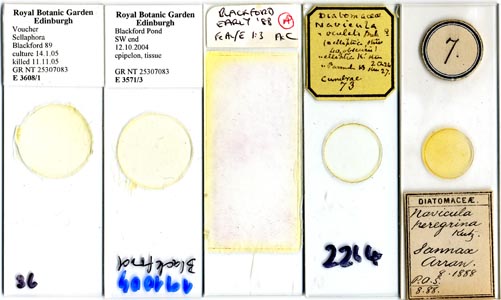Introduction
Until c. 1990, the Royal Botanic Garden Edinburgh held only a very small collection of diatom slides (c. 400), dating from the middle of the 19th century. Most of these slides were made by G.A. Walker Arnott, Regius Professor of Botany at the University of Glasgow from 1845 to 1868, and may have arrived in Edinburgh through correspondence with John Hutton Balfour, who was Arnott's counterpart in Edinburgh (Regius Professor of Botany 1845–1879). There was no phycologist on the staff of the Royal Botanic Garden Edinburgh for most of the 19th and 20th centuries.
In 1990, I was appointed to the staff of the Royal Botanic Garden as Deputy Director and Head of Science and brought my own slide collection to the Garden with me from the University of Edinburgh. At that time, my collection consisted of a few thousand slides, dominated by samples of natural populations and cytological preparations from Scottish (especially Edinburgh) lakes and ponds, and miscellaneous benthic samples from marine and freshwater habitats, principally from Scotland and SW England. In many cases, the slides are accompanied by specimen tubes containing unmounted material.
Since 1990, the Royal Botanic Garden diatom collection has expanded enormously, through new sampling (especially for the never-completed British Marine Diatom Flora project, and also of lake epipelon and vouchers for life cycle studies, DNA barcoding and speciation research) and major gifts and loans. In the 1990s, a large collection of slides, originally from the University of Glasgow, was transferred from the Scottish Marine Biological Association to the Garden on permanent loan. This collection has two main components: (1) the original 'top' set of slides made by Professor G.A. Walker Arnott and the slides he acquired through correspondence with other mid-19th century diatomists, and (2) slides with picked or strewn specimens made in the late 19th century, possibly for teaching. The Glasgow and Edinburgh sets of Walker Arnott slides have been combined into a single sequence and reorganized by sample number; previously, the Glasgow set had been organized alphabetically according to the first species mentioned on the label. In 1996 I gave up management and returned to full-time research.
Before he died in 2010, Professor Frank Round (University of Bristol) gave his entire slide collection to the Garden, representing 50 years of sampling in Britain, Europe and elsewhere, and this is slowly being transferred to new accommodation in slide cabinets. Dr Martyn Kelly has also deposited slides and unmounted material from UK freshwaters, and the Garden bought a major collection of slides and material of recent and fossil diatoms from Mr Bernard Hartley. Other major holdings include slides from J.R. Carter, R.I. Firth and T.A. Gow, and increasingly the Scottish Environmental Protection Agency.
The Royal Botanic Garden collection now totals c. 50,000
slides. The Walker Arnott collection contains many isotypes for species
described by British diatomists in the 1850s. Otherwise, there are only
a few types (e.g. of species described by myself and colleagues) and
the collection is principally a resource for taxonomic and
speciation research. There are a few exsiccata slides from the
Tempère & Peragallo set.
Details are available on the following collections
David Mann, August 2013


